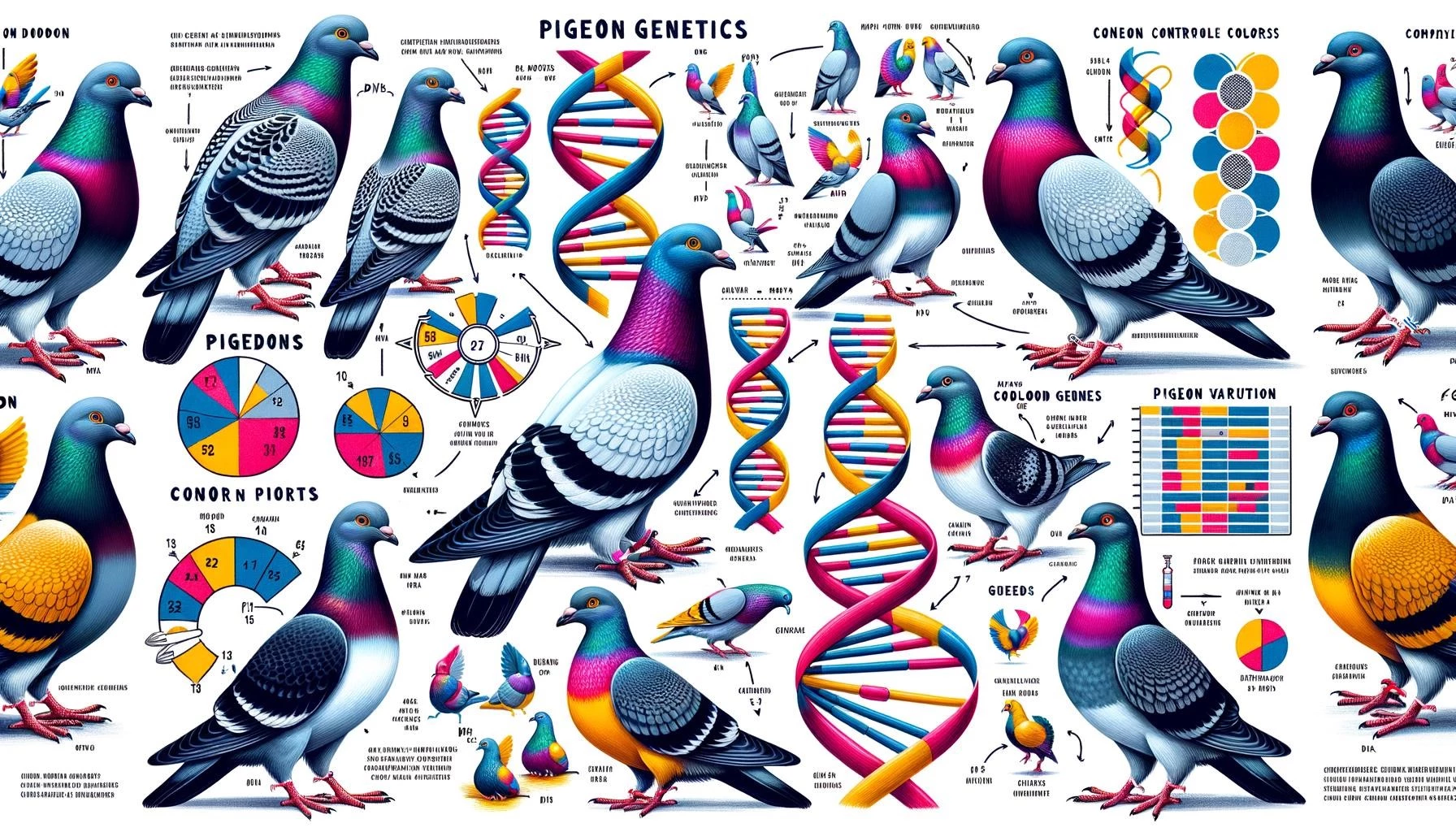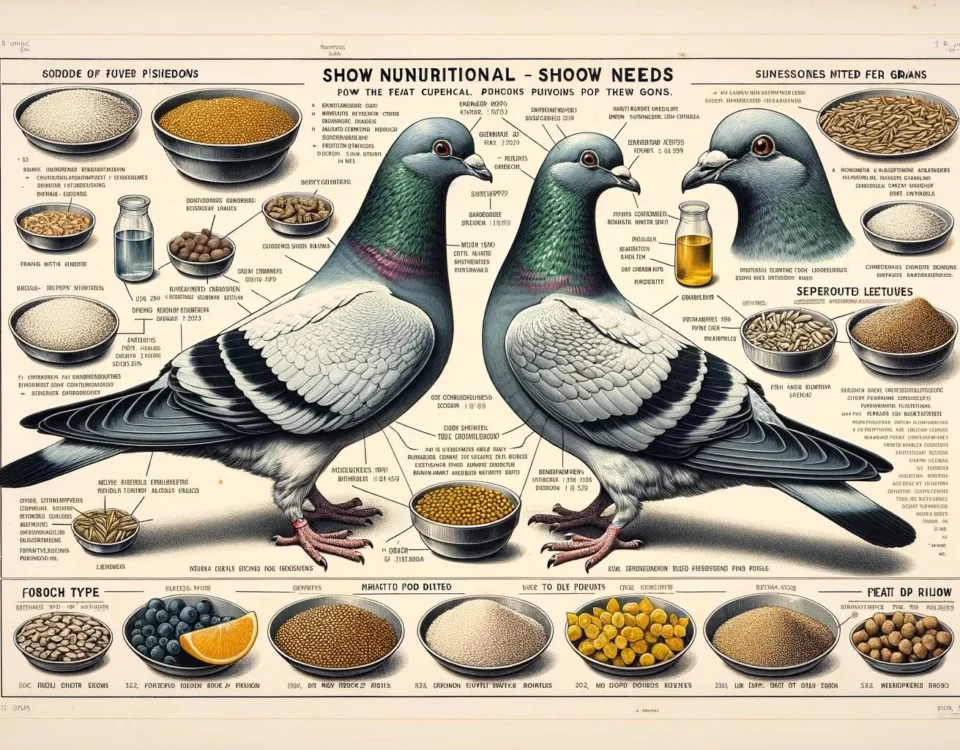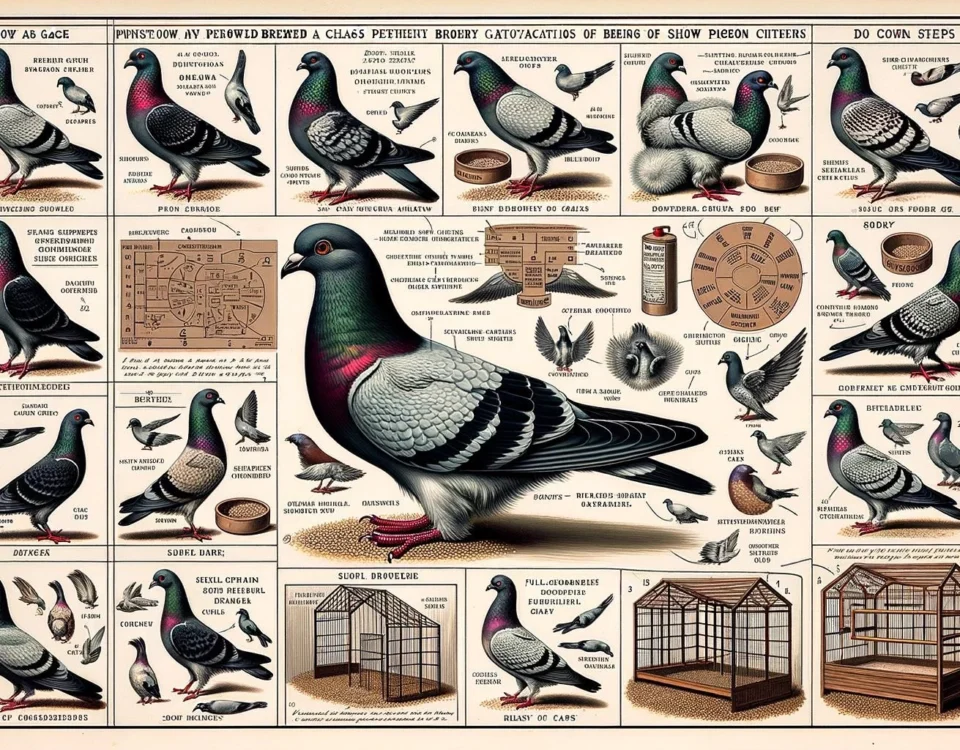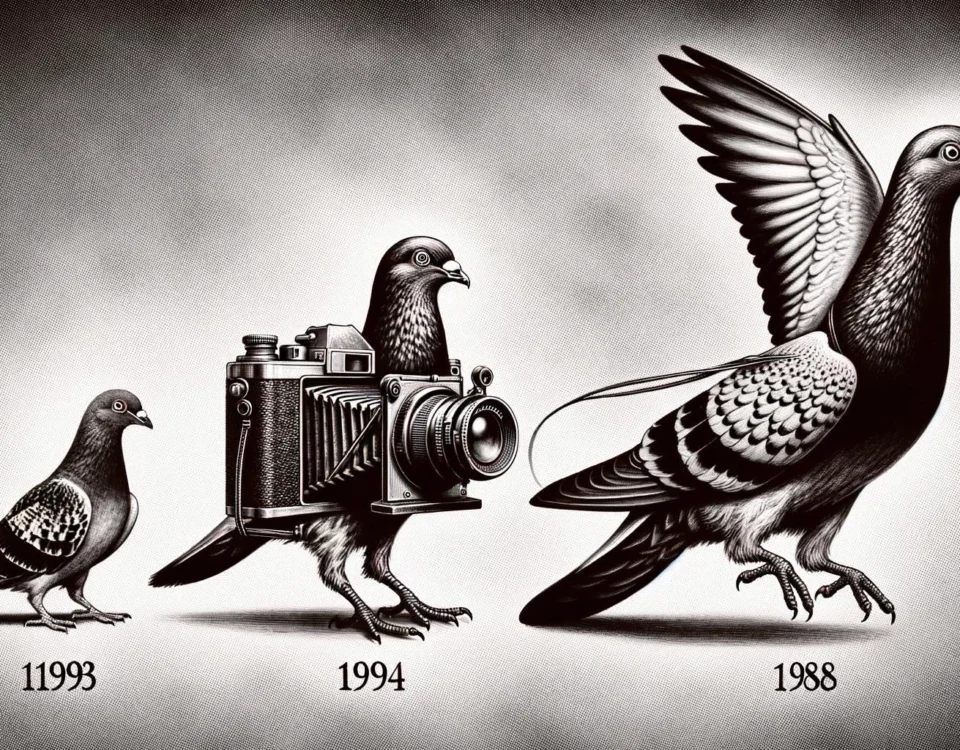Genetic Foundations of Show Pigeons
When it comes to show pigeons, selective breeding is absolutely essential. Breeders focus on highlighting traits that are visually striking, such as vibrant feather colors, unique body shapes, and remarkable flying skills. This method takes advantage of the genetic diversity found in domestic pigeons, gradually refining specific characteristics over numerous generations. The inbreeding of rock pigeons has resulted in fascinating physical changes, leading to a wide variety of breeds.
What’s intriguing is that many of the traits we admire in fancy pigeons—like beautiful feather patterns or distinctive body structures—can be traced back to their wild ancestors. Through selective breeding, breeders enhance these inherited features. A few examples include:
- mutations in the EphB2 gene, which are associated with developing head crests,
- variations in the Tyrp1 gene, influencing the richness of pigmentation,
- selective breeding that amplifies these traits, resulting in visually distinct pigeons.
These breeding practices show just how much artificial selection can influence the genetic makeup of show pigeons. By promoting certain genes while downplaying others, breeders create an astounding variety of breeds, each with its unique appearance and characteristics. Yet, no matter how varied they are, all pigeon breeds share a common evolutionary ancestry with their wild relatives.
Role of Genetics in Pigeon Breeding
Genetics is at the heart of pigeon breeding, influencing traits like color, body form, and flying capabilities. By focusing on selective breeding, enthusiasts strive to enhance these qualities, choosing specific traits to prioritize across generations. This not only results in visually captivating breeds but also preserves the connection to their wild relatives. Through careful selection, breeders bring forth genetic variations, crafting unique varieties that possess desirable traits.
Artificial Selection and Variety Development
Artificial selection is pivotal in shaping the diverse characteristics found in show pigeons. Breeders target specific traits to boost both the aesthetics and functionality of these birds, including:
- eye-catching color patterns,
- distinctive body shapes,
- improved flight capabilities.
By thoughtfully selecting and mating pigeons with these traits, breeders actively influence the genetic diversity within domesticated pigeon populations.
For example, selective breeding has intensified mutations in genes like EphB2, associated with head crests, and Tyrp1, linked to pigmentation. These focused efforts have led to a remarkable array of pigeon breeds while still honoring their lineage with wild rock pigeons.
Interfertility and Genetic Approaches
The ability of different pigeon breeds to interbreed is crucial for genetic research, providing insights into the genes responsible for traits such as:
- feather patterns,
- pigmentation,
- body structure.
This interbreeding capability allows breeders to perform genetic mapping, uncovering how specific genetic components influence these features.
Moreover, studying interfertile pigeon populations offers valuable insights into:
- the inheritance patterns of traits that commonly appear together,
- the phenomenon where genes for these traits are situated close to one another on chromosomes,
- the evolutionary journey of show pigeons.
Interfertility illuminates how selective breeding has shaped the diverse characteristics of show pigeons while maintaining ties to their ancestral roots.
Color Genetics in Show Pigeons
The study of color genetics in show pigeons revolves around the specific genes that dictate feather colors and patterns. At the core are three main pigments—brown, black, and red—which combine to create the rich palette we see in these birds. Different genetic mutations lead to the remarkable variety among breeds. For instance, the brown pigment is derived from a recessive mutation, while the ash-red trait is dominant, often overshadowing others.
Breeders utilize this genetic knowledge to anticipate color outcomes when selecting pairs. This is crucial for ensuring that their pigeons meet the unique aesthetic standards of each breed. To do this effectively, breeders need to grasp fundamental concepts such as:
- dominance,
- recessiveness,
- sex-linked traits.
By applying these principles with care, they can enhance the visual appeal of their birds while keeping genetic diversity intact.
Diving into the world of pigeon color genetics not only aids breeding strategies but also sheds light on the evolutionary processes that have shaped the stunning variety of pigeons we’ve come to admire.
Influence of Pigmentation Genes
Genes responsible for pigmentation are key players in determining the vibrant feather colors we admire in show pigeons. The variety arises from three primary pigments:
- brown,
- black,
- red.
Each pigment is influenced by specific genetic mechanisms. For example, the brown pigment is a result of a recessive mutation, while the ash-red hue comes from a dominant gene that prevails over others. These genetic interactions combine to produce the stunning array of colors found in various pigeon breeds.
Pigeon breeders capitalize on this understanding to predict and create desired feather colors in their birds. By carefully choosing breeding pairs based on their genetic interactions, they enhance the visual appeal of their pigeons while also preserving genetic diversity. This deliberate approach ensures that breed standards are met while nurturing the evolution and refinement of show pigeon varieties.
Color Modifiers and Mutations
Genetic variations and mutations affect the primary pigments—brown, black, and red—in show pigeons, leading to an impressive spectrum of colors and patterns.
- one notable example is the ash-red mutation, a dominant gene that dramatically alters feather coloration,
- this mutation can even eclipse other pigment traits, playing a vital role in breeding outcomes,
- by investigating these genetic factors, breeders can strategically pair birds to achieve specific appearances while ensuring the genetic diversity of pigeon populations remains robust.
Patterns and Color Inheritance
Patterns and color traits in show pigeons are governed by essential genetic principles, such as dominance, recessiveness, and sex-linkage. The wild-type blue bar pattern serves as the reference point against which other variations are measured. Dominant genes have a significant role, often overshadowing recessive ones and determining the visible characteristics in a pigeon’s offspring. For instance, a single dominant mutation can completely transform a natural pattern or color.
Sex-linkage introduces another layer of complexity, as certain traits are passed down through sex chromosomes. This means that inheritance can differ between male and female birds. Breeders must carefully analyze the genetic profiles of parent pigeons, allowing them to predict how their offspring will turn out. By understanding and applying these genetic concepts, they can selectively breed birds with specific patterns while still maintaining the genetic diversity of their populations.
Wing Patterns and Genetic Inheritance
Wing patterns in show pigeons are determined by a single gene with four variations: ‘T-check,’ ‘check,’ ‘bar,’ and ‘barless.’ These variations, or alleles, follow a specific dominance hierarchy:
- ‘T-check’ dominates all others,
- ‘check’ follows ‘T-check’,
- ‘bar’ comes after ‘check’,
- ‘barless’ is the recessive trait in this hierarchy.
Each pigeon carries two copies of this gene—one from each parent—and its visible wing pattern, or phenotype, depends on which allele is dominant in its genetic combination.
This process illustrates how physical traits are shaped by dominant and recessive genes. For example, if a pigeon inherits one ‘T-check’ allele and one ‘barless’ allele, its wings will show the more dominant ‘T-check’ pattern. Understanding these genetic principles helps breeders predict the traits their birds’ offspring will exhibit.
Besides dominance hierarchies, genetic linkage influences the inheritance of wing patterns. The gene responsible for wing patterns is located near another gene known as the spread gene on the same chromosome. Because they are closely positioned:
- these genes tend to travel together during inheritance,
- linkage can affect breeding outcomes,
- this dynamic is often simplified in studies of pigeon genetics.
By understanding both dominance relationships and genetic linkages, breeders can make informed choices when pairing pigeons to achieve desired patterns while maintaining the genetic health of their flocks.
Understanding Wing Pattern Alleles
The genes that dictate wing patterns are crucial in defining the distinctive look of show pigeons. Traits like ‘T-check,’ ‘check,’ ‘bar,’ and ‘barless’ are arranged in a clear dominance hierarchy. For example, dominant genes such as ‘T-check’ can overshadow recessive traits like ‘barless.’ Each pigeon inherits one copy of this gene from each parent, and the combination determines its visible wing pattern, or phenotype.
If a pigeon carries both a dominant allele (like ‘T-check’) and a recessive one (such as ‘bar’), its wings will exhibit the more dominant pattern. This illustrates how dominant and recessive genes work together to influence physical traits.
By examining these genetic principles, breeders gain valuable insights into the appearance of the next generation. Selecting pigeons with specific gene combinations allows them to emphasize desired traits while preserving genetic diversity within their flocks.
Dominance and Recessiveness in Wing Patterns
Genetic traits, such as dominance and recessiveness, are fundamental in shaping the wing patterns of show pigeons. For instance, a dominant gene like ‘T-check’ takes precedence, masking recessive traits like ‘barless.’ Conversely, recessive characteristics only emerge when both alleles carry the recessive gene. By mastering these genetic principles, breeders can anticipate the wing patterns of future generations and make informed pairing decisions.
Genetic Linkage and Chromosomal Influence
Genetic linkage plays a significant role in how wing patterns are inherited in show pigeons. When genes are located close to each other on the same chromosome, they tend to be passed down together more frequently. For example, the gene responsible for wing pattern traits is closely linked with the spread gene. Their proximity often leads to these genes being transmitted as a unit during reproduction.
This understanding of genetic linkage helps breeders predict which traits are more likely to appear together in offspring. By studying these chromosomal relationships, breeders can:
- make more strategic choices in pigeon pairings,
- achieve specific wing patterns,
- ensure genetic diversity within their flocks.
Such insights enhance breeding techniques while improving the chances of developing desired physical characteristics in show pigeons.
Complex Genetic Traits in Show Pigeons
The unique characteristics observed in show pigeons arise from complex interactions among multiple genes. These genetic interactions shape traits like plumage color, feather structure, and body size. Unlike simple Mendelian inheritance, these features often result from polygenic contributions, where many genes collectively define the final appearance. For instance, variations in plumage color frequently arise from pigmentation genes like Tyrp1, alongside other modifiers that adjust the intensity of hues or the distribution of patterns.
The genetic makeup of certain breeds, such as show tipplers, highlights the significance of polygenes in establishing their distinct traits. Breeders must navigate these intricate genetic relationships when selecting for specific traits to ensure consistent appearances while preserving the genetic diversity of the breed.
Feather structure is another area of complexity, influenced by a range of genes that regulate growth direction and texture. This intricate process allows breeders to create stunning exhibition forms across various pigeon varieties. Similarly, body size is shaped by polygenic inheritance, with multiple genetic factors affecting dimensions and proportions unique to each breed.
Understanding how these multiple genes interact is critical for refining breeding practices and achieving exceptional standards in show pigeons. Beyond practical applications, studying these traits also provides valuable insights into evolution and the genetic mechanisms that contribute to the diversity of domestic pigeons.
Show Tippler Genetic Composition
Show Tipplers owe their unique appearance to a combination of essential genes, including T-Pattern, Recessive Red, and Bronze.
- the dominant T-Pattern gene establishes the overall feather pattern,
- Recessive Red serves as a masking gene, hiding other colors when inherited in pairs,
- Bronze gene enhances depth and richness by intensifying feather color.
In addition to these primary traits, modifiers like Dirty, Sooty, Undergrizzle, and Grizzle further refine or enhance the birds’ characteristics. This intricate genetic interplay enables breeders to fine-tune specific traits while preserving the breed’s unique identity.
Role of Secondary Genes and Polygenes
Secondary genes and polygenes play a significant role in the diverse traits observed in show pigeons. While primary genes lay the groundwork for fundamental characteristics, these additional genetic elements refine those features, resulting in unique variations. This interaction shapes intricate details, such as subtle shifts in feather patterns, color intensity, or structural nuances.
For example, plumage texture and body shape are influenced by polygenic inheritance, where multiple genes collectively determine the outcome. Secondary genes can either enhance or diminish the effects of primary ones, adding depth to breeding results. Breeders utilize this knowledge to achieve specific goals:
- refining aesthetic qualities,
- boosting exhibition appeal,
- maintaining genetic diversity within pigeon populations.
A clear understanding of these processes is vital for precision breeding and the creation of distinctive pigeon varieties.
Phenotypic Variation and Exhibition Forms
Through intentional breeding, show pigeons are designed to exhibit distinct traits in both appearance and behavior. Breeders carefully shape features such as:
- size,
- plumage color,
- feather texture,
- temperament.
By leveraging genetic diversity, they can create striking feather patterns or vibrant hues. This process showcases the adaptability of pigeon genetics and results in an impressive array of visual and structural characteristics. By emphasizing these traits, breeders not only enhance the birds’ beauty but also preserve their genetic variety.
Behavioral and Anatomical Traits
Genetic influences are pivotal in shaping the behaviors of show pigeons, such as rolling or tumbling. These traits are often inherited and can be further refined through selective breeding. Similarly, physical characteristics like body size or beak shape are dictated by specific genes.
- features like variations in body structure,
- the curvature of a beak arise from genetic instructions passed down through generations,
- breeders harness this understanding to enhance these qualities.
Breeders aim to cultivate pigeons with optimal appearances and skills.
Genetic Basis of Behavioral Traits
The genetic basis of behavioral traits in show pigeons reveals how inherited genes shape specific actions, such as rolling or tumbling. Rolling, which involves pigeons performing backward somersaults mid-flight, is a striking example of this genetic influence. Research indicates that certain genes play a role in this behavior, providing insights into pigeon domestication and their evolutionary adaptations.
Investigating these behaviors enhances our understanding of how selective breeding can amplify or reduce particular traits. By identifying the genes linked to these actions, breeders can:
- refine their techniques to highlight desired behaviors,
- preserve genetic diversity within pigeon populations,
- develop unique breeds.
This approach deepens our understanding of the fundamental principles driving animal behavior and its evolution over time.
Body Size, Beak Characteristics, and Eye Color
The size of show pigeons is influenced by polygenic inheritance, where multiple genes interact to determine their overall dimensions and proportions. Breeders use targeted techniques to achieve the ideal body size for each breed.
Beak characteristics, including shape and size, are controlled by genes involved in craniofacial development. Changes in these genetic factors yield the unique beak designs that differentiate various breeds, enhancing the visual allure of show pigeons.
Eye color is also influenced by genetics, with numerous alleles producing hues like orange, pearl, or bull eyes. By grasping these genetic principles, breeders can select eye colors that comply with breed standards while keeping healthy levels of genetic diversity.
Inherited Characteristics and Developmental Processes
Inherited traits in show pigeons are transmitted from parent birds to their young through genetic mechanisms. These traits include physical attributes like feather coloration, wing designs, and body size, along with behaviors such as rolling or tumbling. They emerge during the pigeon’s growth and development stages, shaped by genetic factors. For example, genes are critical in defining how feathers form and the structure of bones.
Breeders utilize this knowledge of inheritance to pursue specific goals. By carefully selecting birds with desirable features, they can:
- enhance striking feather patterns,
- develop distinctive body shapes,
- gradually improve the overall appearance of their flock.
Additionally, understanding when specific characteristics appear allows breeders to plan breeding strategies more effectively. This approach aids them in achieving their objectives while maintaining a healthy level of genetic diversity within their pigeon populations.
Genomic Resources and Molecular Investigations
Genomic tools and molecular research are essential for uncovering the genetic traits that define show pigeons. Through genetic mapping, researchers can pinpoint specific chromosomal regions linked to particular features, enabling breeders to predict and select desired characteristics more accurately. The identification of SNPs (Single Nucleotide Polymorphisms) reveals subtle genetic variations that differentiate pigeon breeds.
These advancements not only help identify the genes behind unique traits but also enhance breeding strategies by facilitating more informed choices. For instance, SNP analysis can highlight genetic markers associated with preferred feather patterns or pigmentation, aiding in achieving optimal outcomes while preserving genetic diversity.
Moreover, molecular studies explore developmental biology by examining how gene expression influences both physical characteristics and behavior. When paired with comparative genomics, this research unveils evolutionary connections between domesticated pigeons and their wild ancestors. This integrated approach enriches our understanding of pigeon genetics and promotes responsible breeding practices for the future.
Genetic Mapping and SNPs
Genetic mapping is vital for pinpointing specific gene locations on chromosomes and understanding their links to traits in show pigeons. It provides breeders with essential insights, such as which genes affect characteristics like plumage color, body size, or feather patterns. By examining Single Nucleotide Polymorphisms (SNPs), scientists can investigate genetic variations across pigeon populations. These minor DNA alterations serve as indicators for traits that breeders wish to enhance through selective breeding.
- SNP analysis can reveal markers tied to unique wing designs,
- SNP analysis can reveal markers linked to distinctive pigmentation,
- SNP analysis can strategically assist breeders in pairing pigeons to achieve desired traits.
With this knowledge, breeders can strategically pair pigeons to achieve desired traits while keeping genetic diversity intact. This focused approach streamlines breeding programs and aids in developing new pigeon varieties that meet exhibition standards.
Beyond practical applications, these methods also advance evolutionary research by shedding light on the genetic connections between domesticated pigeons and their wild relatives. Combining molecular studies with traditional breeding techniques allows both breeders and scientists to gain a richer understanding of show pigeon genetics, guiding better decisions for future advancements.
Genomic Studies and Developmental Biology
Genomic research provides profound insights into the genetic makeup of show pigeons, enabling scientists to explore how genes interact to produce distinctive traits. Analyzing entire genomes allows researchers to identify mutations and unravel the mechanisms behind the remarkable diversity seen in these birds. The integration of cutting-edge genomic technology with traditional genetic studies allows for revisiting earlier findings, leading to a more detailed understanding of complex traits.
The field of developmental biology is equally important in this context. It investigates how gene activity affects physical characteristics like feather designs, body shapes, and coloration during a pigeon’s growth. Furthermore, it reveals how genetics govern various developmental stages, equipping breeders with better tools to predict and refine desired traits while ensuring genetic diversity.
Together, these approaches not only enhance breeding strategies but also deepen our knowledge of the evolutionary connections between domesticated pigeons and their wild counterparts.
Comparative Genomics and Evolutionary Insights
Comparative genomics offers a fascinating avenue for scientists to explore the genomes of show pigeons in relation to other bird species, revealing valuable insights into evolutionary patterns and processes. By examining both preserved genetic elements and variations, researchers can pinpoint the genes that dictate specific traits in pigeons. This approach not only traces the development of these characteristics over time but also uncovers the mechanisms behind their adaptation.
Through genomic comparisons, scientists gain a broader understanding of the incredible diversity among bird species, highlighting shared lineages and distinct adaptations. For example, studying the genetic basis of feather color or flight-related traits in pigeons provides crucial insights into the selective pressures that have shaped their evolution. These discoveries clarify how genetic changes drive adaptations to different environments, advancing our grasp of evolutionary biology.
Additionally, comparative genomics enriches our understanding of pigeon domestication by linking their genetics to those of wild relatives like rock pigeons. This connection uncovers subtle yet significant genetic shifts brought about by artificial selection. Ultimately, this research bridges knowledge gaps about how traits emerge and adapt in both wild and domesticated bird populations.








